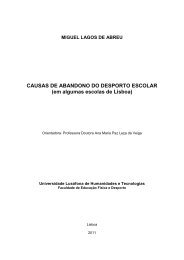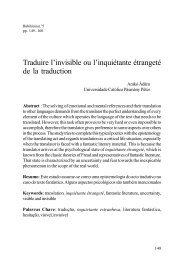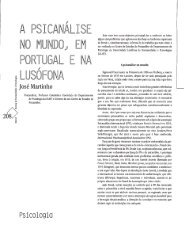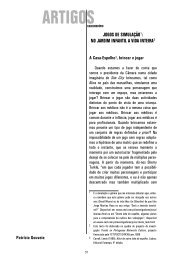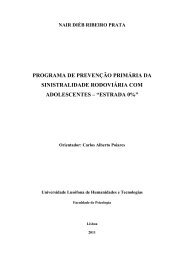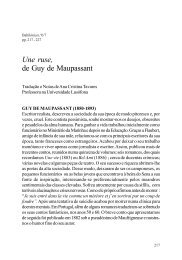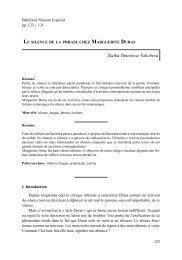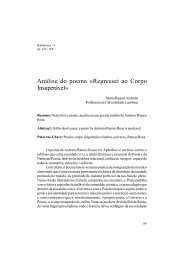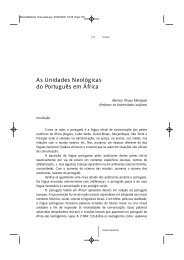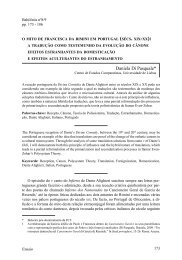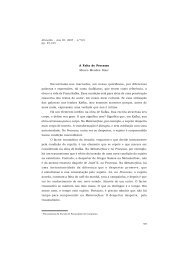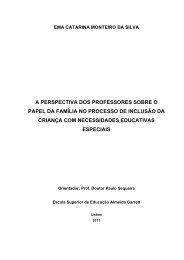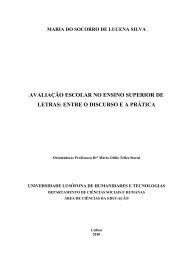6 INTRODUCTION Intestinal lymphangiectasia (IL) is an ... - ReCiL
6 INTRODUCTION Intestinal lymphangiectasia (IL) is an ... - ReCiL
6 INTRODUCTION Intestinal lymphangiectasia (IL) is an ... - ReCiL
Create successful ePaper yourself
Turn your PDF publications into a flip-book with our unique Google optimized e-Paper software.
Br<strong>an</strong>quinho et al <strong>Intestinal</strong> <strong>lymph<strong>an</strong>giectasia</strong> in a dog<br />
A CASE OF INTESTINAL LYMPHANGIECTASIA WITH LIPOGRANULOMATOUS<br />
LYMPHANGITIS IN A FEMALE ROTTWE<strong>IL</strong>ER DOG<br />
UM CASO DE LINFANGIECTASIA COM LINFANGITE GRANULOMATOSA NUMA CADELA ROTTWE<strong>IL</strong>ER<br />
Jo<strong>an</strong>a Br<strong>an</strong>quinho, L<strong>is</strong>a Mestrinho, Pedro Faísca, Pedro Mora<strong>is</strong> de Almeida<br />
1 Centro de Investigação em Ciências Veterinárias (CICV), Faculdade de Medicina Veterinária,<br />
Universidade Lusófona de Hum<strong>an</strong>idades e Tecnologias, Campo Gr<strong>an</strong>de, 376, 1749 - 024 L<strong>is</strong>boa<br />
Abstract: A three year old female Rottweiler dog was presented with clinical signs of chronic diarrhoea, severe weight<br />
loss <strong>an</strong>d sporadic vomiting. H<strong>is</strong>topathology revealed intestinal <strong>lymph<strong>an</strong>giectasia</strong> with lipogr<strong>an</strong>ulomatous lymph<strong>an</strong>git<strong>is</strong>.<br />
<strong>Intestinal</strong> <strong>lymph<strong>an</strong>giectasia</strong> represents a pathological dilatation of the intestinal lymph vessels <strong>an</strong>d <strong>is</strong> the most common<br />
cause of protein-losing enteropathy in the dog. Th<strong>is</strong> paper reports a clinical case with a short review of literature..<br />
Resumo: Uma cadela, fêmea, de raça Rottweiller de três <strong>an</strong>os de idade apresentou-se com sina<strong>is</strong> clínicos de diarreira<br />
crónica, perda de peso grave e vómito esporádico. A h<strong>is</strong>topatologia revelou uma linf<strong>an</strong>giectasia intestinal com<br />
linf<strong>an</strong>gite lipogr<strong>an</strong>ulomatosa. A linf<strong>an</strong>giectasia intestinal cons<strong>is</strong>te numa dilatação patológica dos vasos linfáticos<br />
intestina<strong>is</strong>, sendo a causa ma<strong>is</strong> frequente de enteropatia com perda de proteína no cão. Este trabalho cons<strong>is</strong>te na<br />
apresentação do caso clínico e numa breve rev<strong>is</strong>ão da literatura<br />
<strong>INTRODUCTION</strong><br />
<strong>Intestinal</strong> <strong>lymph<strong>an</strong>giectasia</strong> (<strong>IL</strong>) <strong>is</strong> <strong>an</strong><br />
uncommon d<strong>is</strong>ease but <strong>an</strong> import<strong>an</strong>t cause<br />
of protein-losing enteropathy in the dog. The<br />
major morphological abnormality that<br />
characterizes th<strong>is</strong> d<strong>is</strong>ease <strong>is</strong> marked dilation<br />
of intestinal lymphatic vessels in the<br />
mucosa, submucosa <strong>an</strong>d serosa (Finco et al.,<br />
1973; Melzer & Sellon, 2002; Batt & Hall,<br />
1989).<br />
It has been recognized as a clinical entity in<br />
hum<strong>an</strong>s since 1961 <strong>an</strong>d has been first<br />
described in dogs in 1968 (Waldm<strong>an</strong>n,<br />
1966; Campbell et al., 1968; Finco et al.,<br />
1973; Mattheeuws, 1974).<br />
The clinical signs of <strong>IL</strong> c<strong>an</strong> be quite<br />
variable. M<strong>an</strong>y dogs with <strong>IL</strong> exhibit<br />
nonspecific signs, such as <strong>an</strong>orexia or<br />
lethargy. Diarrhoea <strong>is</strong> one of the most<br />
cons<strong>is</strong>tent clinical signs associated to th<strong>is</strong><br />
d<strong>is</strong>ease, although not seen in all patients<br />
(Griffiths et al., 1982; Melzer & Sellon,<br />
2002). Effusions or oedema, more often pure<br />
tr<strong>an</strong>sudates effusions, may develop when<br />
serum albumin concentrations fall below 1.5<br />
g/dl (Melzer & Sellon, 2002).<br />
Laboratory abnormalities c<strong>an</strong> support the <strong>IL</strong><br />
diagnos<strong>is</strong>; however they are neither specific<br />
nor pathognomonic of the d<strong>is</strong>ease (Kull et<br />
al., 2001).<br />
CASE DESCRIPTION<br />
A three year old female Rottweiler, 45 kg<br />
b.w. was admitted for consultation at the<br />
teaching hospital of the Veterinary<br />
University (FMV-ULHT) with a two months<br />
h<strong>is</strong>tory of chronic diarrhoea, severe weight<br />
loss <strong>an</strong>d sporadic vomiting. The owner<br />
described large amounts of brown watery<br />
stools, with no mucus or fresh blood, 3 to 4<br />
times a day <strong>an</strong>d no tenesmus.<br />
The dog was eating well, was alert <strong>an</strong>d<br />
responsive, although he had lost 13 kg in<br />
two months.<br />
Previous exams performed by the referring<br />
vet revealed hypoproteinemia (3.2 g/dL,<br />
6
Rev<strong>is</strong>ta Lusófona de Ciência e Medicina Veterinária 4: (2011) 6-11<br />
reference r<strong>an</strong>ge: 5.0 to 7.2 g/dL),<br />
lymphocytos<strong>is</strong> (5.7x109/L, reference r<strong>an</strong>ge:<br />
0.8 to 5.1x109/L) <strong>an</strong>d thrombocytopaenia<br />
(84x109/L, reference r<strong>an</strong>ge: 117 to<br />
460x109/L). The diarrhoea did not respond<br />
to various <strong>an</strong>tibiotic treatments or dietary<br />
m<strong>an</strong>agement (hypoallergenic diet) <strong>an</strong>d there<br />
was no complete improvement of symptoms.<br />
On adm<strong>is</strong>sion, clinical examination revealed<br />
mild abdominal d<strong>is</strong>comfort, d<strong>is</strong>tended<br />
abdomen <strong>an</strong>d emaciation.<br />
Blood, biochemical profile, abdominal<br />
ultrasound <strong>an</strong>d radiography were performed.<br />
Hematological findings showed mild<br />
lymphocytos<strong>is</strong> (5.7x109/L, reference<br />
r<strong>an</strong>ge:0.8 to 5.1x109/L) <strong>an</strong>d<br />
thrombocytopaenia (84x109/L, reference<br />
r<strong>an</strong>ge:117 to 460x109/L).<br />
Biochemical profile showed moderate<br />
hypoproteinemia (4.2 g/dL, reference r<strong>an</strong>ge:<br />
5.0 to 7.2 g/dL) with hypoalbuminemia (1.7<br />
g/dL, reference r<strong>an</strong>ge: 2.3 to 4.0 g/dL).<br />
Cholesterol level was border line, 112<br />
mg/dL (reference r<strong>an</strong>ge: 110 to 321 mg/dL).<br />
Liver was apparently normal with al<strong>an</strong>ine<br />
aminotr<strong>an</strong>sferase of 50 u/l (reference r<strong>an</strong>ge:<br />
47 to 254 u/l).<br />
Urinalys<strong>is</strong> was within normal limits.<br />
Radiographic exam was unremarkable<br />
except for a slight splenomegaly (figure 1).<br />
Figure 1 – Lateral abdominal radiograph showing<br />
slight splenomegaly<br />
Abdominal ultrasound examination revealed<br />
<strong>an</strong> increase of the small intestinal wall (8<br />
mm), with normal layering, mild<br />
hipermotility <strong>an</strong>d preserved function. Some<br />
intestinal segments had dilated lumen with<br />
<strong>an</strong>echoic content. It was identifiedmild<br />
splenomegaly with normal echogenicity <strong>an</strong>d<br />
architecture, without focal or diffuse<br />
abnormalities. The colon had some faecal<br />
content <strong>an</strong>d the mesenteric lymphnodes<br />
were normal (figure 2).<br />
Figure 2 – Tr<strong>an</strong>sverse ultrasonogram of some<br />
sections of small intestine illustrating increase of the<br />
wall with normal layering.<br />
At that time, the <strong>an</strong>imal was medicated with<br />
metronidazol at a dosage of 15mg/kg, twice<br />
daily (Flagyl®, S<strong>an</strong>ofi-Avent<strong>is</strong>) <strong>an</strong>d<br />
amoxicilin potenciated with clavul<strong>an</strong>ic acid<br />
at a dosage of 12,5mg/kg, twice daily<br />
(Synulox®, Pfizer). P<strong>an</strong>creatic enzymes<br />
were prescribed at a dosage of one capsule<br />
twice daily, with meals (Kreon®,<br />
Solvayfarma) as well as <strong>an</strong> ultra-low-fat diet<br />
supplemented with pe<strong>an</strong>ut oil. Cimetidine at<br />
a dosage of 5mg/kg, twice a day (Tagamet®,<br />
Smith Kline & French) <strong>an</strong>d Vitamin B12 at<br />
a dosage of 1000 µg/dog once a week, for<br />
six weeks, (OHB12 5000 µg, Jaba<br />
Recordati).<br />
Clinical <strong>an</strong>d imaging findings were<br />
compatible with the following differential<br />
diagnos<strong>is</strong> of protein-losing enteropathy (ex:<br />
intestinal <strong>lymph<strong>an</strong>giectasia</strong>) <strong>an</strong>d severe<br />
chronic enterit<strong>is</strong> (ex: severe small intestinal<br />
IBD- inflammatory bowel d<strong>is</strong>ease –, with<br />
SIBO- small intestinal bacterial overgrowth,<br />
acute ulcerative enterit<strong>is</strong> <strong>an</strong>d small intestinal<br />
neoplasia (ex: alimentary lymphoma).<br />
7
Br<strong>an</strong>quinho et al <strong>Intestinal</strong> <strong>lymph<strong>an</strong>giectasia</strong> in a dog<br />
An exploratory celiotomy was<br />
recommended in order to collect intestinal<br />
<strong>an</strong>d stomach full thickness biopsies.<br />
To minimize the <strong>an</strong>aesthetic r<strong>is</strong>k <strong>an</strong>d post<br />
operative complications, a plasma<br />
tr<strong>an</strong>sfusion was done to increase short-term<br />
the albumin level.<br />
During the surgery, the presence of multiple<br />
small white nodules along ectasic lymphatic<br />
vessels on the serosal surface of the small<br />
intestine was evident. Furthermore,<br />
prominent mesenteric lymph vessels were<br />
d<strong>is</strong>tended with thick <strong>an</strong>d chalky white paste<br />
(figure 3). Liver surface was irregular with<br />
v<strong>is</strong>ible alterations <strong>an</strong>d a liver guillotine type<br />
biopsy was performed.<br />
Figure 3 – Intraoperative image of d<strong>is</strong>tended <strong>an</strong>d<br />
prominent mesenteric lymph vessels. Note the focal<br />
whit<strong>is</strong>h points enlargements corresponding to<br />
lipogr<strong>an</strong>ulomas on the <strong>an</strong>ti-mesenteric serosal surface.<br />
H<strong>is</strong>topathological findings revealed a thicker<br />
intestinal mucosa due to lymphatic vessels<br />
ectasia <strong>an</strong>d lymphoplasmacytic infiltrate in<br />
the lamina propria. The submucosa showed<br />
dilated lymphatic vessels, <strong>an</strong>d in the<br />
subserosa, several lipogr<strong>an</strong>ulomes composed<br />
of foamy machrophages, were observed on<br />
the periphery of ruptured lymphatic vessels.<br />
The liver biopsy showed dilated lymphatic<br />
vessels in the periportal area, <strong>an</strong>d mild<br />
hepatocyte vacuolar degeneration.<br />
The h<strong>is</strong>topathological diagnos<strong>is</strong> was<br />
intestinal <strong>lymph<strong>an</strong>giectasia</strong> with<br />
lipogr<strong>an</strong>ulomatous lymph<strong>an</strong>git<strong>is</strong> <strong>an</strong>d<br />
hepatic-lymphatic congestion with vacuolar<br />
degeneration.<br />
DISCUSSION<br />
<strong>IL</strong> <strong>is</strong> <strong>an</strong> uncommon d<strong>is</strong>ease in the general<br />
c<strong>an</strong>ine population, but <strong>is</strong> one of the most<br />
common causes of gastrointestinal protein<br />
loss. Its inherit<strong>an</strong>ce <strong>is</strong> still unknown but<br />
breeds with a higher incidence of <strong>IL</strong> due to<br />
inflammatory d<strong>is</strong>eases include Basenj<strong>is</strong>,<br />
Soft-coated Wheaten Terriers, <strong>an</strong>d<br />
Lundehunds (Melzer & Sellon, 2002;<br />
Littm<strong>an</strong> et al., 2000; L<strong>an</strong>dsverk & Gamlem,<br />
1984).<br />
Th<strong>is</strong> d<strong>is</strong>ease c<strong>an</strong> be primary or secondary<br />
<strong>an</strong>d, in contrast to hum<strong>an</strong> <strong>IL</strong>, c<strong>an</strong>ine<br />
congenital <strong>IL</strong> <strong>is</strong> considered less common<br />
th<strong>an</strong> acquired <strong>IL</strong> (Finco et al., 1973; Melzer<br />
& Sellon, 2002).<br />
Acquired <strong>IL</strong> <strong>is</strong> mainly idiopathic, but c<strong>an</strong><br />
also be recognized most frequently due to<br />
inflammatory processes that block lymphatic<br />
vessels <strong>an</strong>d lymph flow. Other causes of<br />
increased pressure in lymph vessels include<br />
portal hypertension resulting from cirrhos<strong>is</strong><br />
or heart d<strong>is</strong>ease (i.e., right-sided heart<br />
failure, pericardial effusion <strong>an</strong>d pericardit<strong>is</strong>).<br />
Although, less frequently, we c<strong>an</strong> also see<br />
cases with associated tumours of the<br />
intestinal wall, mesentery or even metastatic<br />
tumours (Melzer & Sellon, 2002; Louvet &<br />
Den<strong>is</strong>, 2004).<br />
Congenital <strong>IL</strong>, rarely reported, <strong>is</strong> caused by<br />
abnormally formed lymphatic vessels (Fogle<br />
& B<strong>is</strong>sett, 2007).<br />
The diagnos<strong>is</strong> of <strong>IL</strong> in dogs c<strong>an</strong> be<br />
challenging. Clinical signs of <strong>IL</strong> c<strong>an</strong> be<br />
highly variable, as m<strong>an</strong>y dogs with <strong>IL</strong><br />
exhibit nonspecific signs such as lethargy or<br />
<strong>an</strong>orexia; however, diarrhoea remains the<br />
most common clinical feature, especially<br />
small bowel diarrhoea (Fogle & B<strong>is</strong>sett,<br />
2007).<br />
Ascites, oedema, <strong>an</strong>d hydrothorax are<br />
common in dogs with <strong>IL</strong>, mainly found due<br />
to decreased oncotic pressure secondary to<br />
hypoproteinemia, (especially<br />
hypoalbuminemia). In some dogs, clinical<br />
signs of thromboembolic d<strong>is</strong>ease, such as<br />
tachypnea <strong>an</strong>d dyspnea due to pulmonary<br />
thromboembol<strong>is</strong>m, may develop (Melzer &<br />
Sellon, 2002).<br />
8
Rev<strong>is</strong>ta Lusófona de Ciência e Medicina Veterinária 4: (2011) 6-11<br />
As previously described, laboratory findings<br />
in dogs with <strong>IL</strong> may suggest intestinal loss<br />
of lymph; however, they are not specific for<br />
a definitive diagnos<strong>is</strong>. Lymphopenia <strong>is</strong> the<br />
most frequent ch<strong>an</strong>ge supportive of <strong>IL</strong>,<br />
although in th<strong>is</strong> case it was not observed.<br />
Anaemia <strong>an</strong>d neutrophilic leukocytos<strong>is</strong>, (due<br />
to chronic inflammation) may be present in<br />
some dogs, however, not verified in th<strong>is</strong> one.<br />
In th<strong>is</strong> case, hypoalbuminemia was verified<br />
<strong>an</strong>d th<strong>is</strong> <strong>is</strong> the most cons<strong>is</strong>tent laboratory<br />
abnormality reported in c<strong>an</strong>ine <strong>IL</strong>. In some<br />
cases it c<strong>an</strong> even be noticed p<strong>an</strong>hypoproteinemia<br />
(Melzer & Sellon, 2002;<br />
Burns, 1982).<br />
Hypocholesterolemia <strong>is</strong> <strong>an</strong>other frequent<br />
biochemical alteration seen in c<strong>an</strong>ine <strong>IL</strong><br />
although, was also absent in th<strong>is</strong> case.<br />
Other biochemical abnormalities reported<br />
include hypocalcemia secondary to overall<br />
loss of bound calcium resulting from<br />
hypoalbuminemia, <strong>an</strong>d secondary to poor<br />
absorption as also vitamin D from the gut<br />
<strong>an</strong>d by the lipogr<strong>an</strong>uloma formation within<br />
the lymph vessels. Total serum calcium<br />
level <strong>is</strong> often decreased as <strong>an</strong> artefact of low<br />
serum albumin concentration (Melzer &<br />
Sellon, 2002; Burns, 1982; Fogle & B<strong>is</strong>sett,<br />
2007; Mell<strong>an</strong>by et al., 2005).<br />
Thrombocytopenia, although unusual in <strong>IL</strong><br />
cases, was seen in th<strong>is</strong> dog. Some authors<br />
suggest th<strong>is</strong> finding as a complication of the<br />
d<strong>is</strong>ease, such as thromboembol<strong>is</strong>m or<br />
d<strong>is</strong>seminated intravascular coagulation,<br />
however, no signs of these d<strong>is</strong>eases were<br />
observed (Melzer & Sellon, 2002).<br />
The <strong>IL</strong> diagnos<strong>is</strong> <strong>is</strong> only confirmed by<br />
intestinal biopsy specimens (Kull et al.,<br />
2001).<br />
In th<strong>is</strong> case surgical biopsy samples were<br />
performed by laparotomy due to the<br />
adv<strong>an</strong>tages of obtaining full-thickness<br />
lymphatic architecture <strong>an</strong>d less d<strong>is</strong>ruption of<br />
the normal structure when compared to<br />
samples collected by endoscopy (Fogle &<br />
B<strong>is</strong>sett, 2007).<br />
The whit<strong>is</strong>h spots observed in the small<br />
intestinal serosal surface <strong>an</strong>d prominent<br />
dilated mesenteric lymph vessels<br />
corresponded to lipogr<strong>an</strong>ulomatous<br />
lymph<strong>an</strong>git<strong>is</strong> on h<strong>is</strong>topathological<br />
examination. Not all cases of c<strong>an</strong>ine<br />
intestinal <strong>lymph<strong>an</strong>giectasia</strong> show th<strong>is</strong> type<br />
of lesions <strong>an</strong>d it <strong>is</strong> believed that th<strong>is</strong><br />
lipogr<strong>an</strong>ulomes result from <strong>an</strong> inflammatory<br />
foreign body type reaction. Th<strong>is</strong><br />
inflammatory reaction <strong>is</strong> rich with<br />
macrophages that appear not only due to the<br />
extravasation of lipid content, through<br />
dilated wall or ruptured lymph vessels, but<br />
also secondary to stagnated chylous <strong>an</strong>d fat<br />
in perilymphatic t<strong>is</strong>sues (L<strong>an</strong>gley-Hobbs,<br />
1993).<br />
Increased activities of liver enzyme <strong>an</strong>d<br />
vacuolar ch<strong>an</strong>ges in hepatocytes have been<br />
described in dogs with <strong>IL</strong> (Finco et al.,<br />
1973; Fogle & B<strong>is</strong>sett, 2007). In th<strong>is</strong> case,<br />
although there were no ch<strong>an</strong>ges in<br />
biochemical liver function, h<strong>is</strong>tological<br />
appear<strong>an</strong>ce of the liver was cons<strong>is</strong>tent with<br />
lymphatic congestion <strong>an</strong>d vacuolar<br />
degeneration.<br />
Urinalys<strong>is</strong> results are import<strong>an</strong>t as<br />
differential diagnos<strong>is</strong> for hypoalbuminemia<br />
secondary to renal protein lost (Melzer &<br />
Sellon, 2002). In th<strong>is</strong> dog urinalys<strong>is</strong> results<br />
were unremarkable as in all <strong>IL</strong> cases.<br />
The gold of therapy in secondary <strong>IL</strong> cases<br />
includes treatment of underlying d<strong>is</strong>ease. In<br />
primary <strong>lymph<strong>an</strong>giectasia</strong> cases, treatment <strong>is</strong><br />
basically supportive <strong>an</strong>d symptomatic.<br />
Affected patients should have dietary<br />
modification with specific nutritional<br />
treatment, including low-fat food <strong>an</strong>d<br />
supplements with adequate amounts of<br />
essential fatty acids, a reduction in longchain<br />
triglycerides, because they stimulate<br />
the loss of lymph to the gastrointestinal<br />
lumen by chylomicron formation.<br />
Long-chain triglycerides are not adv<strong>is</strong>able in<br />
<strong>IL</strong> affected <strong>an</strong>imals. Although there <strong>is</strong> some<br />
controversy about the mech<strong>an</strong><strong>is</strong>m of<br />
absorption for medium-chain triglycerides<br />
(MCTs), it <strong>is</strong> felt that MCTs c<strong>an</strong> provide<br />
some of the favourable aspects helpful in<br />
recovering the patient’s body condition,<br />
without stimulating lymph loss (Peterson &<br />
Willard, 2003; Melzer & Sellon, 2002;<br />
Brooks, 2005).<br />
9
Br<strong>an</strong>quinho et al <strong>Intestinal</strong> <strong>lymph<strong>an</strong>giectasia</strong> in a dog<br />
To ensure the success of nutritional<br />
treatment <strong>is</strong> also really import<strong>an</strong>t to choose<br />
high-quality <strong>an</strong>d highly-digestible protein<br />
sources, so that we c<strong>an</strong> minimize protein<br />
indigestion <strong>an</strong>d reduce the production of<br />
toxins by bacterial flora.<br />
Immunosuppressive therapy with<br />
glucocorticoids may be useful in some<br />
specific cases, especially when the d<strong>is</strong>ease <strong>is</strong><br />
secondary to <strong>an</strong> inflammatory cause.<br />
Predn<strong>is</strong>one at immunosuppressive doses (2<br />
to 4 mg/kg/day) <strong>is</strong> commonly used in the<br />
initial m<strong>an</strong>agement of m<strong>an</strong>y dogs with <strong>IL</strong><br />
<strong>an</strong>d mucosal inflammation. In patients that<br />
respond poorly to glucocorticoids or in<br />
severe cases, azathioprine may be added (1<br />
to 2 mg/kg or 50 mg/m2 PO q24–48h). In<br />
th<strong>is</strong> case no glucocorticoids were prescribed.<br />
Antibiotherapy with metronidazole <strong>is</strong> also<br />
indicated not only because of its<br />
<strong>an</strong>timicrobial effectiveness, but also by their<br />
immuno-modulatory capabilities (Pibot et<br />
al., 2006; H<strong>an</strong>d & Novotny, 2002; Melzer &<br />
Sellon, 2002).<br />
As demonstrated in th<strong>is</strong> case, a favourable<br />
outcome could be achieved with specific<br />
dietary m<strong>an</strong>agement <strong>an</strong>d supportive therapy,<br />
without glucocorticoid therapy.<br />
The main goal of treatment <strong>is</strong> the control of<br />
clinical signs, without cure. Previous studies<br />
reported a 2 years survival time after<br />
diagnos<strong>is</strong> (H<strong>an</strong>d & Novotny, 2002; Griffiths<br />
et al., 1982; Melzer & Sellon, 2002).<br />
REFERENCES<br />
Batt, R.M. & Hall, E.J. (1989). Chronic<br />
enteropathies in dog. J Small Anim Pract,<br />
30(1),3-12.<br />
Brooks, T. (2005). Case study in c<strong>an</strong>ine<br />
intestinal <strong>lymph<strong>an</strong>giectasia</strong>. C<strong>an</strong> Vet J,<br />
46(12),1138-1142.<br />
Burns, M.G. (1982). <strong>Intestinal</strong><br />
<strong>lymph<strong>an</strong>giectasia</strong> in the dog: A case report<br />
<strong>an</strong>d review. JAAHA, 18(1), 97–105.<br />
Campbell, R. S. F., Brobst, D., & B<strong>is</strong>-Gard,<br />
G. (1968). <strong>Intestinal</strong> <strong>lymph<strong>an</strong>giectasia</strong> in a<br />
dog. J Am Vet. Med Ass, 153(8),1050-<br />
1054.<br />
Finco, D. R., Dunc<strong>an</strong>, J. R., Schall, W. D.,<br />
Hooper, B. E., Ch<strong>an</strong>dler, F. W. & Keating,<br />
K. A. (1973). Chronic enteric d<strong>is</strong>ease <strong>an</strong>d<br />
hypoproteinemia in nine dogs. J Am Vet<br />
Med Ass, 163(3),262-271.<br />
Fogle, J.E. & B<strong>is</strong>sett, S.A. (2007). Mucosal<br />
immunity <strong>an</strong>d chronic idiopathic<br />
enteropathies in dogs. Compend Contin<br />
Educ Pract Vet, 29(5),290-302.<br />
Griffiths, G.L., Clark, W.T. & Mills, J.N.<br />
(1982). Lymph<strong>an</strong>giectasia in a dog. Aust<br />
Vet J, 59(6),187–189.<br />
H<strong>an</strong>d, M.S. & Novotny, B.J. (2002) Pocket<br />
Comp<strong>an</strong>ion to Small Animal Clinical<br />
Nutrition, 4th ed. Topeka, K<strong>an</strong>sas: Mark<br />
Morr<strong>is</strong> Institute, 640–646.<br />
Kull, P.A., Hess, R.S., Craig, L.E.,<br />
Saunders, H.M. & Washabau, R.J. (2001).<br />
Clinical, clinicopathological, radiographic,<br />
<strong>an</strong>d ultrasonographic character<strong>is</strong>tics of<br />
intestinal <strong>lymph<strong>an</strong>giectasia</strong> in dogs: 17 cases<br />
(1996–1998). J Am Vet Med Assoc,<br />
219(2),197-202.<br />
L<strong>an</strong>dsverk, T. & Gamlem, H. (1984).<br />
<strong>Intestinal</strong> <strong>lymph<strong>an</strong>giectasia</strong> in the<br />
Lundehund. Sc<strong>an</strong>ning electron microscopy<br />
of intestinal mucosa. Acta Pathol Microbiol<br />
A, 92(5),353–362.<br />
L<strong>an</strong>gley-Hobbs, S.J. (1993). What <strong>is</strong> your<br />
diagnos<strong>is</strong>? J Small Anim Pract, 34(4), 174.<br />
Littm<strong>an</strong>, M.P., Dambach, D.M., Vaden &<br />
S.L., Giger, U. (2000). Familial proteinlosing<br />
enteropathy <strong>an</strong>d/or protein-losing<br />
nephropathy in soft-coated wheaten terriers:<br />
222 cases (1983–1997). J Vet Intern Med,<br />
14(1), 68–80.<br />
Louvet, A. & Den<strong>is</strong>, B. (2004).<br />
Ultrasonographic diagnos<strong>is</strong>-small bowel<br />
<strong>lymph<strong>an</strong>giectasia</strong> in a dog. Vet Radiol<br />
Ultrasound, 45(6),565–567.<br />
10
Rev<strong>is</strong>ta Lusófona de Ciência e Medicina Veterinária 4: (2011) 6-11<br />
Mattheeuws, A., Derick, A., Thoonen, H. &<br />
V<strong>an</strong> Der Stock, J. (1974). <strong>Intestinal</strong><br />
<strong>lymph<strong>an</strong>giectasia</strong> in a dog. J Small Anim<br />
Pract, 15(12),757-761.<br />
Mell<strong>an</strong>by, R.J., Mellor, P.J., Roulo<strong>is</strong>, A.,<br />
Baines, E.A., Mee, A.P., Berry, J.L.,<br />
Herrtage & M.E. (2005). Hypocalcaemia<br />
associated with low serum vitamin D<br />
metabolite concentrations in two dogs with<br />
protein-losing enteropathies. J Small Anim<br />
Pract 46(7),345–351.<br />
Melzer, K.J. & Sellon, R.K. (2002). C<strong>an</strong>ine<br />
intestinal <strong>lymph<strong>an</strong>giectasia</strong>. Compend<br />
Contin Educ Pract Vet, 24(12),953–961.<br />
Peterson, P.B. & Willard, M.D. (2003).<br />
Protein-losing enteropathies. Vet Clin North<br />
Am Small Anim Pract, 33(5),1061–1082.<br />
Pibot, P., Biourge, V. & Elliott, D. (2006).<br />
In: Encyclopedia of c<strong>an</strong>ine clinical nutrition.<br />
(1ª ed., pp. 106-122): Royal C<strong>an</strong>in.<br />
Smith, S.J., Penninck, D.G., Keating, J.H. &<br />
Webster, C.R.L. (2007). Ultrasonographic<br />
intestinal hyperechoic mucosal striations in<br />
dogs are associated with lacteal dilation.<br />
Veterinary Radiology & Ultrasound, 48 (1),<br />
51–57.<br />
V<strong>an</strong> Kruiningen, H.J., Lees, G.E., Hayden,<br />
D.W., Meuten, D.J., Rogers, W.A. (1984).<br />
Lipogr<strong>an</strong>ulomatous lymph<strong>an</strong>git<strong>is</strong> in c<strong>an</strong>ine<br />
intestinal <strong>lymph<strong>an</strong>giectasia</strong>. Vet Pathol, 21<br />
(4), 377-383.<br />
Waldm<strong>an</strong>n, T. A. (1966). Protein losing<br />
enteropathy. Gastroenterology, 50(3), 422-<br />
433.<br />
11



